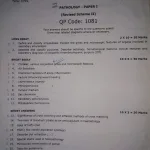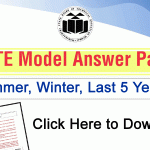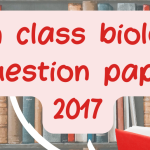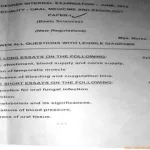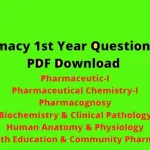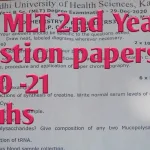Pathology Sample Questions and Answers:
Q: What is the most common cause of anemia in chronic kidney disease?
A: The most common cause of anemia in chronic kidney disease is decreased production of erythropoietin by the kidneys.
Q: Describe the characteristic changes in liver histology seen in chronic hepatitis.
A: Chronic hepatitis typically shows lymphocytic infiltration, fibrosis, and regeneration nodules in liver histology.
Q: What is the significance of Reed-Sternberg cells in diagnosing lymphoma?
A: Reed-Sternberg cells are diagnostic for Hodgkin’s lymphoma and indicate the presence of this specific type of lymphatic cancer.
Q: How does amyloidosis affect organ function?
A: Amyloidosis leads to organ dysfunction by depositing amyloid proteins in extracellular tissues, disrupting normal function.
Q: What is the role of tumor markers in cancer?
A: Tumor markers are used to help diagnose, monitor treatment response, and detect recurrence of cancer.
Q: Explain the pathology behind rheumatic heart disease.
A: Rheumatic heart disease is caused by an autoimmune response to Streptococcus infection that results in heart valve damage.
Q: What are the histological features of acute myocardial infarction?
A: Features include coagulative necrosis, neutrophil infiltration, and eventually fibrosis and scar formation.
Q: Identify the common mutations associated with colorectal cancer.
A: Common mutations include APC, KRAS, and p53 gene mutations.
Q: What is the difference between carcinoma in situ and invasive carcinoma?
A: Carcinoma in situ is confined to the epithelium and has not breached the basement membrane, whereas invasive carcinoma has penetrated it and spreads to other tissues.
Q: How does Helicobacter pylori contribute to peptic ulcer disease?
A: Helicobacter pylori causes chronic inflammation, leading to ulcers in the stomach and duodenal lining.
Pharmacology Sample Questions and Answers:
Q: What is the mechanism of action of ACE inhibitors in hypertension?
A: ACE inhibitors block the conversion of angiotensin I to angiotensin II, leading to vasodilation and reduced blood pressure.
Q: How do beta blockers prevent cardiac arrhythmias?
A: Beta blockers decrease heart rate and myocardial contractility, reducing myocardial oxygen demand and arrhythmia risk.
Q: Describe the use of methotrexate in rheumatoid arthritis.
A: Methotrexate acts as an immunosuppressant by inhibiting the metabolism of folic acid, reducing inflammation in joints.
Q: What is the primary benefit of using clopidogrel in cardiac patients?
A: Clopidogrel inhibits platelet aggregation, significantly reducing the risk of thrombotic stroke or myocardial infarction.
Q: Explain the adverse effects of corticosteroids.
A: Adverse effects include immunosuppression, increased risk of infections, osteoporosis, and hyperglycemia.
Q: What role does digoxin play in heart failure management?
A: Digoxin increases cardiac output by increasing the force of myocardial contraction, beneficial in heart failure.
Q: How do antipsychotic medications manage schizophrenia symptoms?
A: They block dopamine receptors in the brain, reducing symptoms like hallucinations and delusions.
Q: What is the rationale for using combination therapy in tuberculosis?
A: Combination therapy prevents the development of drug resistance and is more effective in eliminating the infection.
Q: Describe the drug interaction between warfarin and antibiotics.
A: Antibiotics can alter gut flora and vitamin K metabolism, enhancing the anticoagulant effect of warfarin and increasing bleeding risks.
Q: How does the pharmacokinetics of a drug affect its dosing schedule?
A: Pharmacokinetics, including absorption, distribution, metabolism, and excretion, determines the optimal dosing frequency to maintain therapeutic levels without causing toxicity.
Physiology Sample Questions and Answers:
Q: Explain the role of the sodium-potassium pump in cell physiology.
A: The sodium-potassium pump helps maintain cellular homeostasis by regulating ion gradients across the cell membrane, crucial for nerve impulse transmission and muscle contraction.
Q: How does the renin-angiotensin system regulate blood pressure?
A: This system increases blood pressure by producing angiotensin II, which constricts blood vessels and stimulates aldosterone release to increase sodium and water retention.
Q: What is the function of surfactant in the lungs?
A: Surfactant reduces surface tension in the alveoli, preventing lung collapse during exhalation and facilitating gas exchange.
Q: Describe the process of synaptic transmission at a chemical synapse.
A: Neurotransmitters released from the presynaptic neuron cross the synaptic gap to bind receptors on the postsynaptic neuron, transmitting the signal.
Q: What is the significance of the blood-brain barrier?
A: The blood-brain barrier protects the brain from harmful substances in the blood while allowing essential nutrients to pass through.
Q: How does cardiac output change during exercise?
A: Cardiac output increases due to a higher heart rate and stroke volume, meeting the increased oxygen and nutrient demands of muscles.
Q: Explain how blood pH is regulated by the kidneys.
A: The kidneys regulate blood pH by excreting excess hydrogen ions and reabsorbing bicarbonate from urine.
Q: What is the role of leptin in body weight regulation?
A: Leptin is produced by adipose cells and helps regulate energy balance by inhibiting hunger, contributing to appetite control.
Q: How does insulin facilitate glucose uptake into cells?
A: Insulin binds to receptors on cell surfaces, triggering glucose transporters to move to the cell membrane and increase glucose uptake.
Q: Describe the physiological changes that occur during the fight or flight response.
A: This response increases heart rate, blood pressure, and energy availability, preparing the body for rapid action in response to perceived threats.
Top Indian Books Complementing Marrow Question Bank PDF for Medical Students
-
“Essentials of Medical Physiology” by K. Sembulingam – Published by Jaypee Brothers Medical Pub; covers detailed physiological mechanisms with clinical correlations, focusing on question formats similar to oral exams and practicals.
-
“Review of Pathology and Genetics” by Gobind Rai Garg – Published by Jaypee Brothers; includes multiple choice questions, explanations, and illustrations targeting key pathological concepts and genetic disorders.
-
“Comprehensive Guide to Obstetrics and Gynecology” by Richa Saxena – Published by Jaypee Brothers Medical Pub; offers extensive coverage of obstetrics and gynecology with case studies and recent advances reflected in question styles.
-
“Self Assessment and Review of Biochemistry” by Rebecca James – Published by Jaypee Brothers Medical Pub; features a mix of explanatory questions and answers focusing on biochemistry’s role in medicine.
-
“Pharmacology for Medical Graduates” by Tara Shanbhag – Published by Elsevier India; this book provides scenario-based questions for deep understanding of pharmacological treatments and their mechanisms.
-
“Textbook of Microbiology & Immunology” by Subhash Chandra Parija – Published by Elsevier India; the book includes a comprehensive set of questions focusing on microbiological techniques and immunological disorders.
-
“Illustrated Synopsis of Dermatology & Sexually Transmitted Diseases” by Neena Khanna – Published by Elsevier India; presents visual and descriptive questions focused on clinical dermatology and STDs.
-
“A Practical Guide to Operative Surgery” by S. Das – Published by S. Das Publications; features surgical techniques through a question and answer format, ideal for practical exams.
-
“Pediatrics: Questions and Answers” by Arvind Shenoi – Published by Jaypee Brothers Medical Pub; focuses on case-based questions in pediatrics, mirroring real-life scenarios and clinical reasoning.
-
“Orthopedics Quick Review” by Apurv Mehra – Published by Thieme; this guide includes high-yield orthopedic facts and figures alongside questions that help in understanding complex structures and injuries.
-
“ENT Questions and Answers” by Renuka Bradoo – Published by Thieme; offers a detailed exploration of otolaryngology through frequently asked questions in clinical settings.
-
“Fundamentals of Pathology” by Harsh Mohan – Published by Jaypee Brothers Medical Pub; provides a detailed analysis of pathological conditions with questions suitable for advanced understanding and exams.
-
“Textbook of Forensic Medicine and Toxicology” by V.V. Pillay – Published by Paras Medical Publisher; contains detailed forensic science questions, case discussions, and explanations crucial for understanding legal aspects of medicine.
-
“Concepts in Pathology” by Devesh Mishra – Published by Elsevier India; structured to assist with conceptual and analytical questions in pathology, focusing on integrative and diagnostic skills.
-
“Clinical Cases in Medicine” by Praveen Aggarwal – Published by Jaypee Brothers; includes clinical scenario-based questions that are essential for practical exams and real-world medical problem solving.
-
“Anatomy Questions for the MRCS” by Christopher Wood – Published by CBS Publishers; contains anatomy questions formatted specifically for the MRCS exams but equally beneficial for comprehensive understanding in medical studies.
-
“Medical Genetics” by G. P. Pal – Published by CBS Publishers; focuses on genetics in medicine with a question and answer format that emphasizes problem-solving in genetic disorders.
-
“Basics of Anesthesia” by Manuel Pardo – Published by Elsevier India; provides multiple choice questions and explanatory answers on anesthesia techniques and protocols.
-
“Internal Medicine: Just the Facts” by Kevin Martin – Published by McGraw Hill Education; features questions designed to provoke critical thinking and application in internal medicine scenarios.
-
“Radiology Secrets” by Drew Torigian – Published by Elsevier India; includes a comprehensive set of questions and answers, highlighting key imaging techniques and diagnostic procedures in radiology.
Marrow Question Bank PDF: A Comprehensive Tool for Medical Students
The journey to becoming a medical professional is rigorous and demanding. One of the most effective resources for medical students preparing for their exams is the Marrow Question Bank PDF. This tool is designed to provide an extensive range of questions that cover all the essential areas of the medical curriculum, making it an invaluable asset for exam preparation.
What Makes Marrow Question Bank Stand Out?
The Marrow Question Bank PDF distinguishes itself with its comprehensive coverage of the medical syllabus. Compiled by seasoned medical professionals and educators, it offers a deep dive into various subjects such as Anatomy, Physiology, Pathology, Pharmacology, and more. The questions are meticulously crafted to mirror the format and complexity of medical examinations, ensuring that students are well-prepared for actual exam conditions.
One of the key features of the Marrow Question Bank is its up-to-date content. Medical sciences are constantly evolving, and this question bank adapts to the latest medical guidelines and discoveries. This ensures that students are studying the most current and relevant information, which is crucial for their success in both exams and future medical practices.
Structured Learning Approach
The Marrow Question Bank PDF is organized systematically, allowing students to focus on one area at a time. Each section is structured to enhance learning by gradually increasing the difficulty level of the questions. This structured approach helps in building a solid foundation of knowledge, followed by advanced problem-solving skills. Additionally, detailed explanations accompany each question, providing deeper insights and aiding in the consolidation of knowledge.
Accessibility and Convenience
Another significant advantage of the Marrow Question Bank PDF is its accessibility. Being a digital resource, it allows students to study anywhere and anytime, fitting seamlessly into their busy schedules. The format of the question bank is compatible with various devices, making it easy to access on laptops, tablets, and smartphones. This flexibility is particularly beneficial for medical students who often have unpredictable and packed routines.
SEO-Friendly Aspects
The Marrow Question Bank PDF targets critical keywords such as “medical exam preparation,” “medical question bank,” “comprehensive medical guide,” and “medical student resource,” ensuring that it reaches its intended audience effectively. Its relevance to medical students searching for reliable and thorough exam preparation tools makes it an optimal choice for their study needs.
FAQ for Marrow Question Bank PDF
Q: What subjects does the Marrow Question Bank PDF cover?
A: The question bank covers all major medical subjects including Anatomy, Physiology, Pathology, Pharmacology, Microbiology, and more.
Q: Is Marrow Question Bank suitable for all medical exams?
A: Yes, the questions are designed to prepare students for various medical exams, including university exams and national level postgraduate entrance tests.
Q: How often is the Marrow Question Bank updated?
A: The question bank is updated regularly to reflect the latest medical guidelines and research, ensuring that the content remains current and relevant.
Q: Can I access the Marrow Question Bank PDF offline?
A: Yes, once downloaded, the PDF can be accessed without an internet connection, making it convenient for on-the-go studying.
Q: Are there explanations for each question in the Marrow Question Bank PDF?
A: Yes, detailed explanations are provided for each question, which are vital for understanding complex concepts and effective revision.
Q: How can the Marrow Question Bank PDF help in practical exams?
A: Besides theoretical knowledge, the question bank includes clinical scenario-based questions that enhance decision-making skills and practical knowledge, which are crucial for handling real-life medical situations.
This resource is tailored to harness the potential of medical students by equipping them with the knowledge, skills, and confidence to excel in their examinations and future medical careers.
Latest Posts
- Step-by-step guide to download and apply for jee mains admit card 202
- Comprehensive 2025 government holidays and recruitment details for job seekers
- JEE Mains Admit Card 2025: Your Step-by-Step Guide to Downloading the Hall Ticket
- Everything You Need to Know About 2025 Government Holidays Recruitment
- Comprehensive Guide to rrb d group recruitment 2025 – Eligibility, Vacancies, and Application
- Detailed guide to nps trust recruitment 2025 vacancies, eligibility and apply process
- Comprehensive guide to hpcl recruitment 2025 notification, vacancies, and application process
- ignou bed admission 2025 complete recruitment guide with eligibility and process
- Comprehensive Guide to Indian Army Agniveer Recruitment 2025 Notification and Jobs
- Everything You Must Know About CBSE Board Exams 2025 Changes & New Rules

